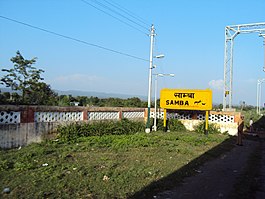Jalandhar–Jammu line
| Jalandhar–Jammu line | |||
|---|---|---|---|
 Samba railway station lies on the Jalandhar–Jammu line | |||
| Overview | |||
| Status | Operational | ||
| Owner | Indian Railways | ||
| Locale | Punjab, Jammu and Kashmir | ||
| Termini | Jalandhar City Jammu Tawi | ||
| Service | |||
| Operator(s) | Northern Railway | ||
| History | |||
| Opened | 1971 | ||
| Technical | |||
| Track length | 216 km (134 mi) | ||
| Number of tracks | 2 | ||
| Track gauge | 5 ft 6 in (1,676 mm) broad gauge | ||
| Electrification | completed | ||
| Operating speed | up to 130 km/hr (Jalandhar–Pathankot section) | ||
| Highest elevation | Jalandhar Cantonment 256 m (840 ft), Pathankot Cantonment 352 m (1,155 ft), Jammu Tawi 414 m (1,358 ft) | ||
| |||
The Jalandhar–Jammu line is a railway line connecting Jalandhar Cantonment and Jalandhar City in the Indian state of Punjab with Jammu Tawi in Jammu and Kashmir. The line is under the administrative jurisdiction of Northern Railway. This line was made after Indian Independence in 1947. Normally before partition of India and creation of Pakistan, trains to Jammu Tawi from Delhi used to run via Panipat, Ambala Cantonment, Ludhiana, Jalandhar City, Amritsar, Lahore, Narowal and Sialkot. But after partition and creation of Pakistan in 1947, the Sialkot–Jammu Tawi line was dismantled and closed permanently. Jammu and Kashmir became cut off from rest of India. Hence in 1949, it was decided to extend the line from Jalandhar City to Mukerian till Pathankot and after the Indo-Pakistani War of 1965, this line was extended to Jammu Tawi. This 216 km (134 mi) railway line is an important strategic connectivity for Indian Military and Defence.
History[edit | edit source]
The line from Jalandhar City to Mukerian City was constructed in 1915.[1] The Mukerian city to Pathankot jn line was built in 1952. The construction of the Pathankot–Jammu Tawi line was initiated in 1965, after the Indo-Pakistani War of 1965, and opened in 1971.[2] Railway tracks between Jalandhar and Jammu Tawi have been doubled.[3] Electrification of railway track between Jalandhar and Jammu Tawi was completed in 2014.[4]
Speed limit[edit | edit source]
The Jammu–Jalandhar Cantonment line is classified as a "Group B" line and can take speeds up to 130 km/h.
Passenger movement[edit | edit source]
Jalandhar City and Jammu Tawi, on this line, are amongst the top hundred booking stations of Indian Railway.[5]
DMU shed[edit | edit source]
India's first and largest DMU shed at Jalandhar holds 90 units placed in service in rural Punjab. It also houses two BEML-built rail buses which operate on the Beas–Goindwal Sahib line.[6]
Loco sheds[edit | edit source]
Jammu has a trip shed for visiting locos where WDS-4 locos belonging to Shakurbasti shed are retained for long periods. Pathankot Cantonment (Chakki Bank) had a steam shed which has now been decommissioned.[6] Jalandhar City and Ludhiana have Electric Loco Sheds.
Bridges[edit | edit source]
There are many major and minor bridges in the Jalandhar City–Jammu Tawi line. The most important bridges are the 1.38 km (0.9 mi)-long Beas River Bridge at Mirthal, the 0.225 km (0.1 mi)-long Chakki River Bridge at Pathankot, the 2.16 km (1.3 mi)-long Ravi River Bridge at Madhopur, the 1.23 km (0.8 mi)-long Bridge on Degh Nalah at Ghagwal, the 1.09 km (0.7 mi)-long Bridge on Basantar River at Samba and the 1.00 km (0.6 mi)-long bridge on River Unjh at Vijaypur Jammu.
Railway reorganisation[edit | edit source]
Sind Railway (later reorganised as Scinde, Punjab & Delhi Railway) was formed a guaranteed railway in 1856. It constructed broad-gauge railways from Delhi to Multan via Lahore, and from Karachi to Kotri. Multan and Kotri were connected by ferry service on the Indus River. In 1871–72, Indus Valley Railway was formed to connect Multan and Kotri. At the same time, Punjab Northern State Railway started constructing from Lahore towards Peshawar. In 1886, Sind, Punjab and Delhi Railway was acquired by the state and amalgamated with Indus Valley Railway and Punjab Northern State Railway to form North-Western State Railway.[7]
With the partition of India in 1947, North Western Railway was split. While the western portion became Pakistan West Railway, and later Pakistan Railways, the eastern part became Eastern Punjab Railway.[8] In 1952, Northern Railway was formed with a portion of East Indian Railway Company west of Mughalsarai, Jodhpur Railway, Bikaner Railway and Eastern Punjab Railway.[9]
References[edit | edit source]
- ↑ "Hoshiarpur – Punjab District Gazetteers". Chapter VII Communications – Railways. Archived from the original on 4 March 2016. Retrieved 9 February 2014.
- ↑ "IR History: Part V (1970-1995)". IRFCA. Retrieved 9 February 2014.
- ↑ "Jalandhar–Udhampur Railway Track to be Electrified". Jalandhar, Punjab, India. Retrieved 3 January 2014.
- ↑ "Electric engine train on Pathankot–Jammu Tawi track from next month – Latest News & Updates at Daily News & Analysis". dnaindia.com. 22 July 2014. Retrieved 7 April 2018.
- ↑ "Indian Railways Passenger Reservation Enquiry". Availability in trains for Top 100 Booking Stations of Indian Railways. IRFCA. Archived from the original on 10 May 2014. Retrieved 10 February 2014.
- ↑ 6.0 6.1 "Sheds and workshops". IRFCA. Retrieved 5 February 2014.
- ↑ "Digital South Asia Library". Imperial Gazetteer of India, v. 3, p. 398. Archived from the original on 2 February 2014. Retrieved 31 January 2014.
- ↑ SM Imamul Haque (1989). Management of Indian Railways, 1989. ISBN 81-7099-183-8. Retrieved 31 January 2014.
{{cite book}}:|work=ignored (help) - ↑ "Geography – Railway Zones". IRFCA. Retrieved 31 January 2014.
